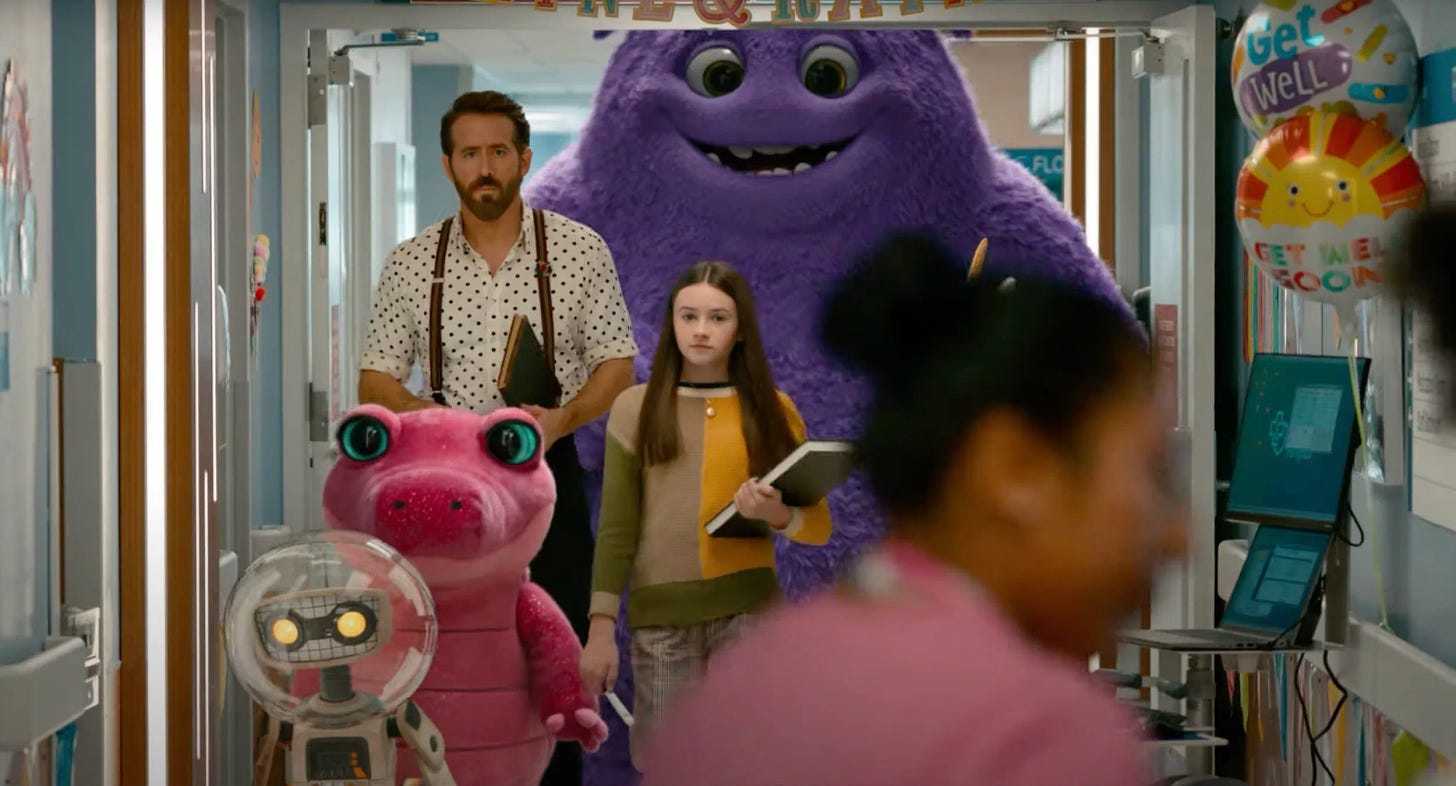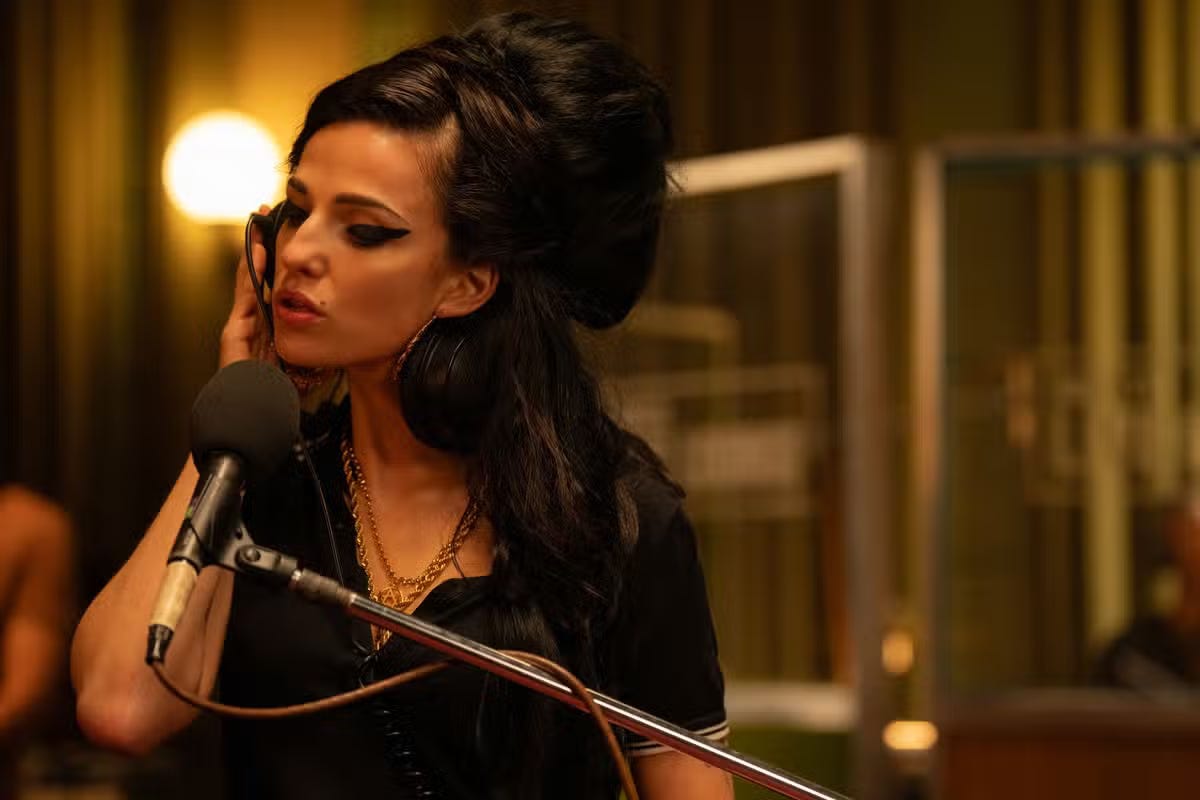In Review: 'IF,' 'Back to Black'
John Krasinski's family-friendly follow-up to the "Quiet Place" movies and an Amy Winehouse biopic add up to the worst review week in Reveal history.
IF
Dir. John Krasinski
104 min.
The new John Krasinski fantasy realizes at least two wishes on a monkey’s paw: One is a return to the renegade Hollywood of the 1970s, when the auteur inmates ran the studio asylum and big-name directors were given carte blanche to realize their weird visions. The other is Ryan Reynolds easing off on his jokey Van Wilder/Deadpool schtick and giving a more grounded performance. And so the spell is cast and now we have IF, a genuine debacle that Krasinski, still flying high from the blockbuster success of A Quiet Place and its sequel, has pushed through Paramount Pictures with seemingly no oversight. That would normally be an exciting and rare development at a time when original ideas don’t generally attract nine-figure budgets, but IF isn’t exactly Brewster McCloud. Krasinski has attempted to make a grand-scale tribute to a childhood creativity and resilience, which here is not only banal, but not thought-through at the most basic level. You know it’s not filmmaking by committee because a committee would have had notes.
If anything, the Reynolds factor is stranger—or, at least, endemic to the overall strangeness of the project. Because while IF may be promoted as a family comedy about two people who can see various cuddly, fun-loving imaginary friends, it has no jokes in it. What it has instead, in terrible abundance, is whimsy, which isn’t the same thing, especially when it’s applied as gloppily as a six-year-old’s peanut-butter-and-jelly sandwich. Some quips from Reynolds might have goosed the film to life, but he instead surrenders to the earnest tone that Krasinski establishes from the beginning, when the death of one parent and the illness of another sends a 12-year-old on a solitary tour through the land of make-believe.
After an opening montage sets up her idyllic childhood in a Brooklyn brownstone and the illness that slowly took her mother, Bea (Cailey Fleming) once again grapples with a sick parent, this time her single father (Krasinski), who is hospitalized for an unspecified, life-threatening illness. (Krasinski seems to believe that a good dad would minimize the problem by dancing around with an IV stand like Fred Astaire rather than speak frankly to his daughter about what’s going on with him.) During his absence, Bea moves back into the brownstone with her grandmother (Fiona Shaw) and soon discovers that she can see imaginary friends (or IFs) sneaking around on the streets. Bea follows one such friend upstairs to her neighbor Cal (Reynolds), who can also see IFs, including the fluffy purple Blue (voiced by Steve Carell) and the floral Blossom (Phoebe Waller-Bridge).
Things get a little wonky from there. Bea and Cal shuttle over to the Wonder Wheel at Coney Island, where several more animated IFs reside (Matt Damon, Emily Blunt, Maya Rudolph, George Clooney, and the late Louis Gossett Jr. are among the celebrity voices), each unattached to their person. So the duo take it upon themselves to play matchmaker with the IFs, providing the kind of companionship that Bea, even in her late adolescence, is missing. There’s no graspable internal logic to any of this, just the idea that imaginary friends are a necessary and vital partner to children of all ages.
IF feels like the work of someone so upset by Bing Bong’s fate in Inside Out that he made an entire movie to bring him back to life. No, Krasinski implies, humans do not outgrow their imaginary companions, but need their support in trying times well into their infantilized adulthoods. The seriousness of that desire blankets IF, from the diffused lighting of cinematographer Janusz Kamińsky to the wall-to-wall score by Pixar composer Michael Giacchino. There’s no doubting the sincerity of Krasinski’s feeling for Bea and other children like her, but like his father in the film, it comes across as tacky and haranguing. C’mon dad. Leave us alone. — Scott Tobias
IF opens tonight in theaters everywhere.
Back to Black
Dir. Sam Taylor-Johnson
122 min.
Why does Back to Black exist? It’s not a question anyone involved with the creation of the film seems to have asked themselves. A dramatization of the life of singer Amy Winehouse, following her from her first steps into a professional career as a teenager to her death from a combination of substance abuse and bulimia at the age of 27 in 2011, the film appears to have been summoned into existence by a combination of reflex and market forces. Amazing artist? Untimely death? You get a biopic. No insights into the subjects, their career, their legacy, or the times in which they lived required.
There’s certainly little of that to be found here. Scripted by Martin Greenhaigh, a music biopic veteran also responsible for the Ian Curtis-focused Control (pretty good) and the John Lennon-as-a-youth film Nowhere Boy (not great, but better than this) and directed by Nowhere Boy’s Sam Taylor-Johnson, Back to Black the cinematic equivalent of someone reciting the saddest story imaginable in a deadening monotone, filing it with incident but offering no comment as to why anything happened. The film moves through moments in Winehouse’s life as if working through a biopic flowchart. Innocence. Flashes of talent. Signs of trouble. Success. Bigger signs of trouble. Then either redemption or death, depending on the subject.
With Winehouse, it ends in death and the way her downfall is depicted here suggests another, more insidious agenda than the mere need to fill a blank spot in the music biopic world. Mitch Winehouse, the fame-seeking father who told her she didn’t need to go to rehab (as immortalized in her most famous song)? He’s just a well-meaning, jazz-loving bloke played by Eddie Marsan. Blake Fielder-Civil (Jack O’Connell), the scuzzy, porkpie-sporting love of her life with whom she had a torturous, tempestuous, and literally toxic codependent relationship? Sure, he’s bad news, but he also gets a scene in which Winehouse explicitly tells him he’s not responsible for her addictions. The management that kept her on the road when she was falling apart? They’re deep in the margins of the story. Even the press that kept vigil outside Winehouse’s apartment gets off easy. The subtext, whether intentional or not, is that Winehouse was just one of those people destined to destroy themselves. What are you going to do?
The only principal players seemingly interested in probing the depths are Leslie Manville as Winehouse’s beloved and influential grandmother and Marisa Abela as Winehouse. Abela does a pretty good job mimicking Winehouse’s seemingly inimitable voice but an even better job of suggesting the turmoil and fragility beneath the make-up and hair. She remains convincing even when the film does not, as in a scene where Fielder introduces her to the music of the great, tough-as-acrylic-nails, not especially obscure ‘60s girl group the Shangri-Las. Chances are someone with a vast knowledge of music history like Winehouse might have heard of them, but the film treats the moment as seismic in implications, leading her to shift her look and musical identity. Abela even manages not to roll her eyes when the film has Winehouse stomp off as she declares she has to “live my songs” or when Winehouse and Fielder-Civil bond over how old stuff was just, like, you know, better than new stuff. Those watching may not be able to share the same restraint. —Keith Phipps
Back to Black opens tonight in theaters everywhere.









The musical biopic has to be the most artistically bankrupt subgenre Hollywood keeps pumping out at this point. Even superhero films are more interesting.
Are imaginary friends real? Not the friends themselves, but the concept of having one.
It's a super common trope in fiction, yet I didnt know a single kid that had one when I was growing up, and don't know a single adult who has admitted to it.
Feels like something that was invented by Disney circa Pete's Dragon and never left.